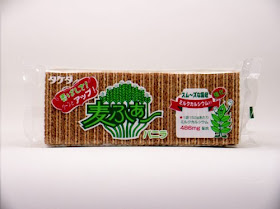I saw these "milk stick wafers" on offer many times at local 100 yen shops like Lawson 100 as well as the hybrid market/100 yen shop "My Basket". I generally had bigger fish to fry and turned up my nose like some snack food snob at this pedestrian offering. Actually, the truth wasn't that I was too good for cheap wafers, but rather that I'd been burned far too often when it came to wafers in Japan. Sure, they could deliver a nice crunch, and often they were calcium fortified, but generally there wasn't much going on in the flavor department.
While I hate to be one of "those" Americans who whines about Japanese sweets in comparison to what I could get back home, I'm afraid that I'm going to have to turn to that sort of loathsome behavior in the case of what we commonly call "sugar wafers" here. In Japan, they rarely put enough cream or sugar between them, or the wafers were too thick and tough. There was one type which was bland, but I liked it anyway and that is the vanilla whole grain ones pictured above. Before I realized that Japanese sweets that were "healthy" and not especially sweet were still packing enough carbohydrate calories to increase my pants size, I used to buy these all of the time and polish off a package in no more than four sittings (sometimes in as few as two). These had a nice earthy whole grain taste that I enjoyed, but they were not what one would call a "sugar wafer", despite appearances to the contrary.
The cookies that I picked up an Hankook Korean market may not look like a traditional sugar wafer, but that is what they taste like. They are just a little unusual in their construction. The outside is standard crispy wafer material and the inside is sweet filling. There are two differences, however, between this and other types of wafers. One is that the thicker construction of this tube style wafer makes it less crispy and ever so marginally tougher. I'm guessing this is intentional to stop them from being brittle enough to shatter at the drop of a case of them being loaded onto a truck. They are surprisingly resilient to clumsy treatment.
OK, there are actually 3 differences... they also have a goofy slogan written on them in English. The Japanese above it just says "milk stick wafers" so this is not a translation.
The other difference is that they have "milk" flavor filling. As I've said before, "milk" is actually a flavor in Japan. It either tastes like powdered milk that has been sweetened (that's when it's really bad) or like condensed milk (that's when it's not so bad). These resemble the latter. Every time I buy one of these, I yearn for some flavor depth of some sort. Would it kill them to add some vanilla? Seriously.
All that being said, these are perfectly serviceable sugar wafers. The main good point is the excellent portion control. When I have a proper bag of sugar wafers, I want to eat a lot of them, but two fingers (53 calories) are in one foil packet so you are discouraged from eating more than one serving. They are sweet enough without being too sweet, and the wafer design makes them far less crumbly than the plank-style ones (which tend to flake off everywhere).
All of that being said, and even given that they only cost $1.29 (119 yen), I wouldn't buy these again. For 99 cents, I can pick up a package of European sugar wafers at a discount store that will have more volume, less wasteful packaging and a better flavor (like hazelnut). It's not that these are bad. It's more that they aren't especially good.





Never been a fan of wafers, the wife on the other hand... she loves it. Again, I'd love to try em, but I think I'd give them to my wife.
ReplyDelete